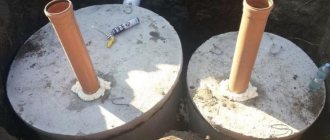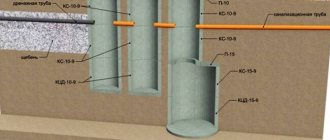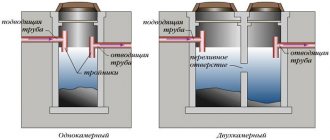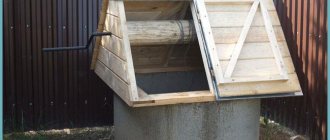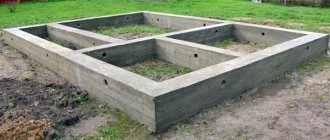Features of the septic tank
Crushed stone pillow
A crushed stone cushion is also used when there is no bottom at the filter well.
The installation scheme of the septic tank is such that the concrete rings must be fastened together with metal plates with bolts or staples. The purpose of such actions is to prevent the rings from shifting due to soil heaving.
Waterproofing seams
An important factor during installation is waterproofing the seams. Conventional waterproofing is not enough, as it does not provide complete isolation of fecal water. Therefore, special insulation is made with waterproofing compounds.
Internal waterproofing of seams and ring surfaces
- For external waterproofing of concrete rings, ordinary roofing felt or special mastic is used.
- For internal waterproofing of concrete rings, special mastic or liquid glass is used.
External waterproofing of concrete rings
Each section of the septic tank must have a hatch that will provide access to the required section at any time.
Depth of septic tank and cesspool
The following factors influence the determination of the depth of a septic tank or cesspool:
- The depth to which the soil freezes.
- The depth at which groundwater occurs.
- Take into account the standard hose length (3m) of the equipment for systematic pumping out of accumulated water. of good.
If it is impossible to locate the septic tank deeper than the groundwater, additional insulation is done. To prevent freezing of collected wastewater.
Not in all cases it is possible to comply with and adhere to established standards. This is due to several factors. Perhaps the main one is the small area of the site. but you need to strive for the ideal!
An alternative to a septic tank made from rings
Cast concrete septic tank
It’s not difficult to build a septic tank with your own hands – the diagram of which is given below.
Scheme of a monolithic septic tank
To do this, it will be necessary to purchase concrete rings, concrete mortar, high-strength plastic, steel and brick. The septic tank must be equipped with a hatch made of durable materials.
After all materials have been purchased, the following steps are performed:
- Trenches for pipes and main frames are dug.
- Then the pipes are installed, after which the formwork is carried out.
- Next, concreting is carried out, evenly from top to bottom.
- While the concrete hardens, a finishing well is installed; for this, brickwork can be used for discharge.
- After the concrete has completely dried, it is necessary to cover the upper part of the septic tank compartments with a roof, in which there should be space for an inspection pipe, as well as for inspection hatches.
Ready-made treatment stations
Installation of a ready-made cleaning system “Tank”
What are the sizes of reinforced concrete rings for sewerage?
If we talk about the sizes of reinforced concrete rings, in general, then you can see these indicators in the same product markings after the letters mentioned above.
Kawabanga! Concrete reinforcement
Manufacturers mostly prescribe dimensions in decimeters.
For example, if we decipher the designation KS-10-6, this means that the diameter of the product in this case is 10 dm or 1 meter.
Accordingly, the height of the ring will be equal to 0.6 m.
Ring sizes KS-10-6
It should be noted that if we talk specifically about the dimensions of concrete rings for sewerage, then everything will be much simpler.
The standard height of one product is 90 cm. The diameter can vary between 1-2 meters.
But, if you need to build a smaller structure or use non-standard rings, you should pay attention to products marked KSD.
The additional wall rings have a height of 30 and 60 cm, allowing, as a result of their combination with conventional CS, to obtain a well of the required height.
Additional wall rings
Advantages and disadvantages of reinforced concrete rings
Before installing a sewer system made of concrete rings, you should consider all the advantages and disadvantages of these products.
The benefits will be as follows:
Reinforced concrete rings - strength, tightness, long service life
- fairly high strength indicators;
- simple and extremely quick installation;
- high tightness, especially with additional waterproofing;
- long service life;
- affordable price.
These include the following points:
Heavy weight, installation by machinery
- the need to rent special equipment to transport the material;
- the heavy weight of the products makes it impossible to install them manually, forcing you to seek the help of special equipment.
It remains to consider the sequence of installation work.
Types of sewer rings and their scope of application
To drain sewer water, pipes are usually used that are made of polymer materials, cast iron, ceramics, asbestos cement, reinforced concrete; these products generally have a small diameter, with the exception of structures made of lightweight plastic components. If a large pipeline diameter is required for laying underground communications, the weight of long pipes becomes too large for transportation and installation of the line, so it is constructed from short rings.
Due to their low cost, wide sewer rings are made only from concrete, and this material currently has no competitors. With the development of modern technologies and the tendency to use polymers in all areas, analogs of concrete products have relatively recently appeared on the market - polymer-sand rings, which are used only for the construction of vertically installed structures.
If in the urban planning field, underground horizontal communications are laid from reinforced concrete rings for transporting organic waste, storm and gray wastewater, they are used as protection for water supply and gas pipelines, then in the household sector their use is of a different nature. In individual areas, reinforced concrete sewer rings serve as the main elements in the construction of the following structures:
Water intake wells. Installation of wells for collecting drinking water from reinforced concrete rings is one of the most popular methods of supplying water to individual residential buildings in urban and rural areas. The mine is dug manually or mechanized, after which sewer wall rings with a lock are immersed in it. If a well is made of concrete rings on the site, the depth of the structure can reach 30 m - in this case, a submersible electric pump is used to draw water.
Septic tanks. Some homeowners use sewer rings to build septic tanks or sedimentation tanks with their own hands, using structures with a closed bottom and top.
Drainage wells. Installation of reinforced concrete rings for sewerage in households is one of the most common areas of their application. Sewage water treated in individual septic tanks is disposed of on its own site, using aeration fields or drainage wells for additional purification and direction of wastewater underground. Many people install the drainage chamber with their own hands from reinforced concrete rings, installing several elements with a locking connection on top of each other in a vertical position.
Rice. 2 Engineering structures made of reinforced concrete rings
Inspection wells. Engineering structures of this type are needed for sewerage in a private house in cases where the underground pipeline has a large length or branches. To carry out cleaning, preventive work and inspection, small diameter wells are placed along the sewer pipeline. They are designed to provide access to inspection hatches installed in pipes for cleaning them in case of blockages and monitoring the condition of the line.
Caisson wells. A well made of reinforced concrete rings is often used to place pumping equipment in it, to protect a well source of water from freezing and precipitation when it is collected by a submersible electric pump or a surface pumping station. The depth of such structures usually does not exceed 2 m; during installation, they often use rings with a finished bottom or upper ceiling with a hole for a hatch; another installation option is the installation of separate round slabs for the bottom and upper manhole. Also, for caisson wells, experienced users purchase ready-made structures with built-in metal running brackets located along the entire height of the wall.
Septic tanks. Often in private households, especially in rural areas, residents who are deprived of access to a centralized sewerage system share waste disposal. They install a separate toilet for feces on the street, and gray water after washing dishes, laundry, cleaning rooms and other household needs is poured through sewer pipes into a drainage sump constructed from concrete rings.
Cellars. Concrete rings with a bottom can be used on a private plot for the construction of cellars intended for storing fruit and vegetable products deep underground in winter and summer.
Horizontal passages. When laying utilities under roads, to transfer water masses to the other side of highways and railways, large-diameter reinforced concrete rings are often used, which are simpler and easier to lay sequentially one after another than to immediately stretch a heavy long pipe.
Rice. 3 Excavation of soil for wells using special equipment
Video
Related Posts
How to make water supply for a private house from a well
Plastic wells for communication sewers: purpose, types, characteristics, price
Repair of faulty sewer wells
Construction of sewer wells: requirements and volume calculation
Send
By clicking the “Submit” button, you accept the terms of the privacy policy and consent to the processing of personal data under the conditions and for the purposes specified in it.
Two-chamber design device
A septic tank, consisting of two chambers, is a practical treatment facility capable of processing organic waste.
The cleaning mechanism is based on the operation of two communicating compartments, inside of which the liquid component and the insoluble solid component are separated by settling.
Each compartment of the two-chamber structure is responsible for specific tasks:
Additional cleaning inside the second chamber is achieved using a crushed stone or gravel filter. It prevents the penetration of insoluble inclusions into soil layers.
The clarified wastewater that has undergone such treatment significantly reduces the total volume of sewage mass, due to which it is possible to call sewer trucks to empty autonomous sewage facilities much less frequently.
Often, instead of filtration wells, filtration fields are placed. They consist of several trenches laid in parallel, the bottom of which is covered with crushed stone and sand.
Kawabanga! Concrete volume calculator
Pipes with perforated walls are laid on top of the filtration bed. The entire structure is covered with crushed stone and sand and covered with soil.
Calculation of tank volume
One of the key conditions for the uninterrupted operation of a treatment plant is the correct calculation of its volume.
To correctly calculate the volume of a septic tank, you need to focus on three parameters:
- The number of people who live in the house permanently.
- Total daily volume of sewage waste per person.
- The period of time during which organic substances have time to be completely processed.
When calculating, it is taken as a basis that the average daily volume of wastewater per household is 200 liters. On average, it takes up to three days to process organic substances inside a treatment plant.
When making calculations, it is also worth taking an additional margin of 15-20%. It will allow you to avoid overfilling the norm in case of a temporary increase in the number of household members and guests staying in the house for several days.
So for a family of four people, a structure with a capacity of 200 liters x 3 days will be required. x 4 people = 2.4 cu. m. We round the value and find that for a family of 4 people you need a septic tank with a capacity of 2.5-3 liters.
Self-construction
In the event that septic tanks are built independently, it will be necessary to make calculations. Building by eye is not profitable. If the chambers are too small, the septic tank will not cope with the load and the water will be treated poorly. If the cameras are excessively large, then the owners will simply waste money on building unreasonably large cameras.
What does it depend on?
For a septic tank to work effectively, it is necessary that the waste water entering it remains inside for at least 72 hours. Only in this case will they have time to defend themselves well. Thus, it is necessary to select a chamber volume that would accommodate the wastewater generated at the serviced facility for three days.
From the above we can conclude that the volume of settling chambers directly depends on the water consumption in the house. And consumption, in turn, depends on the following factors:
- number of residents;
- set of plumbing fixtures.
Formula
How to determine water consumption in a house? As a rule, when building a septic tank, a formula is used to determine the volume of the chambers. The formula looks like this:
V = 1.2 x N x Q x 3,
wherein:
- the symbol V indicates the total volume of the treatment plant chambers;
- the symbol N indicates the number of users;
- the figure 1.2 is a correction factor that is used to create a certain reserve;
- number 3 is the number of days that water should spend in the chambers, this number is determined by building codes;
- The symbol Q indicates the water consumption of one user per day.
How to determine water consumption?
The formula is quite promising, but difficulties arise in determining the daily water consumption per person. Previously, it was customary to assume in calculations that each user spends 15 to 20 deciliters of water per day.
However, this indicator does not take into account the fact that the number of plumbing fixtures and household appliances in modern homes has increased. Today, even in their dachas, people install dishwashers and washing machines, as well as bidets, Jacuzzis and even small swimming pools.
Therefore, if the calculation is carried out for a house with a standard set of plumbing fixtures (toilet, sink, washbasin, shower), then the consumption for each family member can be taken as 15 deciliters. If a bathtub is installed instead of a shower cabin, then for calculations you should take a figure equal to 20 deciliters for each person.
If additional plumbing is installed in the house, the water consumption will increase. So, when installing a washing machine and dishwasher, you should add about 30 liters.
If you plan to install a bidet, then you should add another 40 liters. If a jacuzzi or mini-pool is installed in the house, then the volume of the “additive” depends on the capacity of these plumbing elements.
If the volume of the chambers of a septic tank installed in a small commercial facility (for example, in an office) is calculated, then the water consumption will be relatively small, even if 15 or 20 people use the sewer. Since such a facility does not install baths and showers.
Septic tank installation technology
When installing a two-chamber septic tank made of concrete rings, be prepared for the fact that this is quite difficult and painstaking work. To make your task easier, use the services of special equipment or hire two or three assistants to carry out the work.
It will be difficult for even several workers to lift a heavy ring. Well, installing it exactly in place is even more difficult.
Purchase of materials and components
Concrete rings are available in the market in different sizes. The height of the products is always the same and is 90 cm, but the diameter can vary from 70 to 200 cm.
The volume of a ring directly depends on its diameter. Thus, a reinforced concrete ring with a cross-section of 70 cm has a volume of 0.35 cubic meters. m. And the construction of tanks with a volume of 2.5 cubic meters will require 7-8 such rings.
If you use rings measuring 100 cm, each of which has a volume of 0.7 cubic meters. m, the construction of tanks of the same capacity will require only 4 such rings.
The price of the product depends on its size. Therefore, in order not to make a mistake, before purchasing rings, always calculate the total volume and the required quantity.
Materials you will also need:
- pipes D110-120 mm;
- tees for overflows;
- crushed limestone of three different fractions;
- river sand.
The soil filter in the second chamber is formed from three layers of gravel or crushed stone, the size of the fraction of each underlying layer should be smaller than the fraction of the previous one.
In addition, you will need to stock up on liquid glass, cement for preparing the solution on the site, and polyurethane foam for sealing the joints.
Tools required for work:
- bayonet and shovel;
- building level;
- perforator;
- ladder;
- bucket with rope;
- mixing container;
- narrow spatula;
- wide brush.
To lay sewerage to the septic tank and create overflows, it is permissible to use different types of pipes. More often a polypropylene or asbestos-cement pipeline is installed.
The technology for constructing a septic tank from concrete rings includes a number of standard steps:
Kawabanga! Preparing concrete: proportions in buckets
How to do
The most common construction principle is linear. All columns are lined up on the same line. The storage tanks can be located nearby, and the filtering tank can be located at some distance from them and preferably further away, so that the flowing water does not saturate the soil and freeze, increasing the phenomenon of frost heaving.
Columns line up in one line
General rules for storage columns
It is better to take rings for a septic tank with locks. They are easier to install, they are less likely to move during frost heaving, and the degree of sealing is higher. Before installation, it is advisable to treat them with coating waterproofing. Good results are obtained with bitumen mastic and cement-based deep penetration impregnation (such as Penetron). With this treatment, nothing will leak out of the septic tank, and groundwater will not get inside.
The remaining rules for constructing a septic tank made of concrete rings are as follows:
- The optimal distance between storage columns is 0.5 m. This gap, filled with soil, will act as a buffer during soil movements.
- A layer of crushed stone about 20 cm thick is poured and compacted at the bottom of the pit. It is compacted to a high density, preferably using a powerful tamper. The surface of the bedding must be strictly horizontal and level, without differences. The plane is checked using a building level at least 1.5 meters long (preferably 2 meters).
- For compacted crushed stone:
- Place rings with a bottom. They must be positioned evenly so that the walls are strictly vertical. Then the column will stand firmly.
A ring with a bottom for a septic tank is more convenient
A concrete monolithic slab with a thickness of at least 30 cm and dimensions larger than the device by 20 cm in all directions is poured under the septic tank. The slab must be strictly horizontal and as level as possible. After the concrete has matured (28 days), the first ring is installed on the slab, its joint with the base is carefully sealed. To do this, a roller of concrete mortar with increased waterproofing characteristics (such as Aquacement) is placed under the ring. The squeezed out remains of concrete are used to seal the joints between the rings.
Seal all joints and surface defects with cement-sand mortar or a special hydrophobic solution
Insulate a septic tank from concrete rings to the level of soil freezing with a small margin (+20 cm)
- Made of brick. Plaster the outside and inside, treat both sides with liquid waterproofing. The good thing about this option is that you set the height and dimensions of the hatch yourself, but you will either have to buy a reinforced concrete floor slab for the rings with a hole for the manhole, or fill the floor slab yourself.
Brick “necks” for a septic tank made of concrete rings - Made from special concrete covers with hatches. The same enterprises that produce concrete rings for sewer septic tanks also produce floors with hatches. They are installed on the top ring of the column; standard metal or rubber covers fit under them.
Assembled neck made from a small diameter ring and overlap
Made from monolithic reinforced concrete. The option requires minimal costs, but requires a long period of time and certain skills in creating reinforced concrete structures. It is necessary to assemble the formwork, tie the reinforcing frame, and fill it with concrete. The neck will be ready for use in 28 days.
Installation of inlet and overflow pipes in a septic tank made of concrete rings
Features of the construction of a filtration well
When installing a filtration column, the pit is dug to soils that drain water well. A layer of crushed stone 20-25 cm thick is poured onto the bottom, and a layer of sand 30-40 cm thick is placed on top of it. Rings without a bottom are installed on this bedding. In some cases, a ring with perforations is installed - holes of at least 30-50 mm in diameter (by the way, there are factory ones).
Perforated rings
When installing a perforated ring, it is also advisable to replace the soil around it with crushed stone. This is necessary so that the water drains better. Otherwise, the structure of the filtration well made of concrete rings is the same.
How to bury rings for a septic tank
The most common method is to dig a common pit, install rings using a crane, lay overflow pipes, seal all joints/cracks, seal, insulate, then fill and compact the soil. Everything is not bad, except that the volume of excavated earth is very large. To make everything faster, it’s easier to use the services of an excavator. Doing it manually, with your own hands, takes a long time, but if you hire a team of “diggers,” it will be both time-consuming and expensive. Typically, the cost of a team of diggers is comparable to the cost of calling out special equipment. It’s just that the equipment works for several hours, and the crew for several days. But perhaps this situation is not in all regions.
There is a second way to bury a concrete ring - methodically remove the soil inside the ring and under the wall. Under its own weight, the ring falls down. But only rings without a bottom are buried this way. The bottom will have to be filled later and it will be exclusively inside the ring, which greatly reduces the reliability of the septic tank. In addition, with this option, it is impossible to insulate the septic tank, unless you dig it out to the freezing depth. You will also have to dig trenches to lay overflow pipes. This method is quite problematic for septic tanks, but it can also be used.
Calculator for calculating the height of septic tank chambers made of reinforced concrete rings
The proposed calculator for calculating the height of septic tank chambers will help you get answers to these questions. Of course, working with it requires some explanations, and the reader will find them below, in a special section.
Calculator for calculating the height of septic tank chambers
Go to calculations
Explanations for calculations
It is quite possible to calculate the required volume of a septic tank yourself. Moreover, we will help with this.
Very simple! You need to follow the recommended link to the calculator for calculating the volume of a septic tank located on our portal, indicate the requested values, click the button and get the result!
One of the possible options for a three-chamber septic tank made of concrete rings.
If you choose a calculation for cameras that only consists of rings, then that’s probably it. The learned height will remain to be “transformed” into the number of rings.
Such liners can be produced to order in lengths of up to 4 ÷ 5 meters, which greatly simplifies installation. There are also collapsible options - the required height is obtained from several hermetically connected parts. But in any case, you need to know the height.
And since any liner is always smaller in diameter than the reinforced concrete ring, and sometimes by a considerable amount, the working volume of the chambers also decreases. So this circumstance should not be overlooked.
In any of the options, the result is shown in meters.
Construction of a septic tank: main points of choice
The structure is based on concrete rings and has a round shape.
According to its design, it can be single or multi-chamber. It is advisable to build single-chamber septic tanks if the volume of wastewater per day is no more than 1 m3. The number of rings for the sewer structure is no more than 3-5 pieces. Two-chamber settling tanks are erected with a daily waste volume of up to 10 m3. Three-chamber sedimentation tanks guarantee more thorough cleaning and are installed when daily wastewater volumes exceed 10 m3.
Components of septic tanks:
- The bottom or bottom slab (“PN”) has a diameter corresponding to the cross-section of the wall rings. The task of the bottom slab is to provide a level, sealed and solid foundation necessary for servicing septic tanks and minimizing subsidence of the entire structure on loose, floating soils.
- Wall rings for septic tanks (“KS”) are called the working part, which is formed on the basis of additional, support or wall-type elements. The number and dimensions of products are determined by the calculation of design data.
- Overlap (“PP”) is a floor slab produced on the basis of a brand of wall rings. The covers are equipped with mounting loops and inspection holes, the diameter of which rarely exceeds 0.7 m.
- The neck is a structure formed by wall rings, the diameter of which is smaller than the main size of the structure.
- Hatch - can be either polymer or concrete or cast iron.
Important! When starting the installation of concrete rings, it is necessary to check all products for chips, sagging, and cracks, which can be either a manufacturing defect or occur due to improper transportation of elements.
Standard sizes recommend the following indicators:
The official application from the bookmaker 1xBet is absolutely free and you can click on the link and place bets on sports.
- The height of the manhole is 1150 mm from the main ground level to the bottom level of the floor slab;
- The highest edge of the hatch should not rise above the ground level by more than 0.8 m;
- The inside of the rings for the septic tank, assembled into a structure, are coated with a solution based on cement and water, enriched with calcium nitrate, and the dry layer of plaster should not be more than 20 mm.
Important! Diameter sizes of round single-chamber settling tanks: 1000 mm, 1500 mm, 2000 mm. The height of the working part is 1.8-2.4 m. The calculation of the number of concrete rings is determined based on the diameter and height of the elements involved in the installation of the sewerage system.
How to calculate the volume of a septic tank made of concrete rings
Let's look at the main aspects that influence the choice of the required volume of a septic tank made of concrete rings, and also select reinforced concrete rings for the construction of such a septic tank.
Formula for calculating a septic tank made of concrete rings
V = n * Q * 3/1000 Values of elements: V – volume of septic tank in m3; n – number of consumers permanently residing in the house; Q – water consumption per resident, per day; 3 – duration in days of the wastewater treatment cycle (according to SNiP).
Tags: Concrete rings
Practical application of calculations
The presented method for calculating the volume of a small treatment plant allows you to design a fully functional septic tank on your own or make preparatory estimates for the purchase of a ready-made installation. The method is obviously simple, as well as sufficiently accurate to meet the needs of domestic consumption.
At the same time, it is up to you to decide which method of waste disposal you prefer. On the one hand, a septic tank designed to be assembled from concrete rings will require additional installation efforts and time spent on its construction. However, its relatively low cost will allow you to create wells with a good performance margin. On the other hand, ready-made factory containers guarantee simplified installation and accelerated commissioning of the structure, but for this you will have to pay a significantly larger amount of money than for concrete rings.
What is required to calculate the volume of a septic tank?
Naturally, the key importance when designing an installation is its dimensions, or rather the working (active) volume of the septic tank, which is calculated:
Let's look at how to calculate the volume of a septic tank for a home using simple tabular and formula calculations.
Regulatory Requirements and Regulations
It is necessary to understand that the disposal and disposal of wastewater is clearly regulated by the regulatory documentation of the Russian Federation, non-compliance with which leads to negative consequences both for the ecosystem and for the liability of those responsible. Therefore, when calculating a septic tank for the needs of a household, they rely on a number of standards and rules, in particular:
- SNiP 2.04.03-85 “Sewerage. External networks and structures”, regulating sanitary protection zones around small treatment facilities, as well as adjusting the active volumes of installations.
- SNiP 2.04.01-85 “Internal water supply and sewerage” or their updated version SP30.13330.2012, for determining wastewater flow rates.
- A manual for the design of engineering systems MDS 40-2.200, which provides the main regulatory calculations for the calculation of septic tanks and their auxiliary structures (drainage wells, filtration fields, etc.).
Recommendations for choosing and determining the size of a septic tank based on the calculated volume
Having determined the filling volumes of the treatment station, we adjust the dimensions of the septic tank taking into account safety factors and geometric parameters of the structure.
Capacity adjustment
If we plan to clean the container less than twice a year, then add a reserve (+20%) for sediment:
If necessary, you will need a reserve volume (+20%) if you plan to receive guests often and for a long time. Then the final formula for calculating the active total volume of all chambers or modules (from the bottom to the lower edges of the outlet pipes):
The volumetric characteristics of a treatment plant that is planned to be operated seasonally can, on the contrary, be reduced by 20%.
Rules for proper placement of a septic tank and filter structure on the site
Installation norms and rules are prescribed in the legislative acts of the Russian Federation:
- The septic tank is installed at least 5 m from the residential building. There should be at least 1 m from the border of the plot with neighbors (on either side), provided that people permanently live on their plot, the distance from the fence is increased to 4 m.
- The filtration system is installed at a distance of 8 m from the house. If the filtration fields are designed to process up to 15 cubic meters per day, the distance from the residential building is made at least 15 meters.
- There should be 15 m from the source of water intake, for example, a well or borehole, to the septic tank - this is for sources built against the flow of underwater streams. If the source is built along the flow of the water stream, the septic tank is placed at a distance of 30 m.
- The drain chambers are removed from the main underground gas pipeline by at least 1 m. The level of pressure of the raw materials in the gas pipeline is also taken into account; the standards are specified in SP 62.13330.2011.
If there is a natural reservoir near the site, a septic tank is installed taking into account the type, size, and category of the reservoir. For example, nature-protected lakes are an inviolable territory and therefore the septic tank will have to be installed at a great distance, ensure the maximum degree of wastewater treatment, etc.
- Treatment facilities are located lower in relief from the level of the water supply source. This is required to ensure that wastewater does not enter the groundwater.
- To place the septic tank, choose a place that is not flooded with melt water after the snow melts.
Villages, vegetable gardens and gardening farms (partnerships) may have their own standards for the installation of septic tanks. Violation of internal regulations is fraught with fines, so before starting work it is necessary to clarify the existence of such rules and choose a place that meets all requirements.
